5 Digital Transformation Trends to Future-Proof Your Business
By 2023, direct investments in digital transformation are expected to reach US$7 trillion globally. And just a few years from now, digitally transformed businesses will account for US$53.3 trillion, over half of the global gross domestic product (GDP). Even companies that are cutting spending due to the pandemic are keeping a budget for future-proofing business modifications and to implement digital transformation trends.
According to PWC, only 9% of companies surveyed intend to reduce investments in digital transformation. The figures speak for themselves and show that digital transformation is a business strategy backbone in most companies.
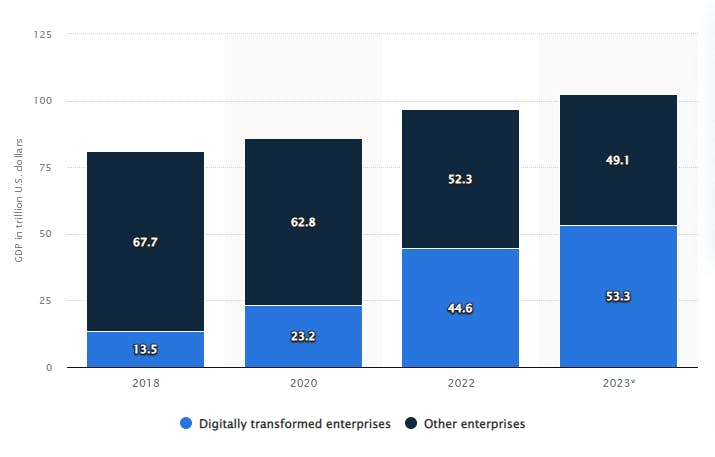
Nominal GDP driven by digitally transformed enterprises and other enterprises globally. Source: Statista
The question is how to build and implement a digital transformation strategy, and which innovations to include in your plan. The solution is a complete approach to changing your company's ecosystem. However, the first step in digital modification is to clearly understand what it is since it’s often confused with digitalisation.
MadAppGang's mission is to build advanced software and get companies ready for digital disruption. With this article, we hope to inform you about digital transformation trends and help you reach your first organisational milestones. But first, let's clarify the notion of digital transformation and see how it differs from digitalisation.
What is digital transformation?
Until recently, business data was analog. Records were kept on paper, in ledgers, or typed into documents. Getting or sending information required lots of time, effort, and devices like xeroxes and faxes. When computers became mainstream, almost all of those ink-on-paper records were converted to digital files. This process of converting information from analog to digital is known as digitisation, and it's not the same as digitalisation or digital transformation.
Digital transformation is about altering the way businesses are run, creating new types of companies and changing the performance of existing ones. Companies that become digital enterprises continuously adapt their business models to incorporate technology. These changes pertain to all areas of business: the products and services on offer, back-office processes, and customer interaction. We have good examples of how companies are changing their operations.
Target’s transformation is a good example here. In 2013, the retailer underwent a pivotal change. At the end of the year, the retail chain saw its profit drop due to a data breach that compromised the data of 110 million customers. This was a disaster, but it prompted top managers to rethink business strategy and invest more in the company’s digital future.
Target built an enterprise platform that handles traffic spikes flawlessly, keeps user data secure, and makes use of modern technologies such as machine learning (ML) and artificial intelligence (AI). For instance, the chain uses ML models to forge replenishment plans and AI-powered predictive analytics to forecast demand and in-store traffic. In 2020 when sales spiked, the new platform allowed Target to order and restock products 25% faster than before.
Digital transformation trends
The main purpose of any digital business transformation is to improve your end-product and current workflow. It's a complex process that includes staff training, improving or changing existing IT facilities, and leveraging tech innovations. To help you plan your company's makeover, we overview the latest innovations and key trends in digital transformation below. Let's take a closer look:
The move to distributed ecosystems
The cloud is essential to digital transformation today. Cloud-native platforms offer elasticity and scalability, faster time to value, and reduced costs. However, the mere fact that an enterprise is cloud-native is not enough to ensure maximum business agility. In this case, a multi-cloud or hybrid cloud strategy makes sense. In both strategies, more than one cloud is used. But a hybrid cloud strategy entails the use of different types (public, private) of clouds, while a multi-cloud combines multiple clouds of the same type.
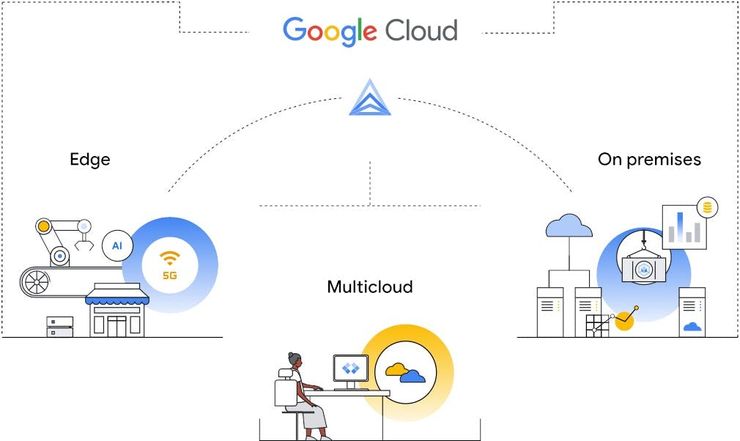
Distributed cloud ecosystem. Source: Google Cloud
Multi-cloud or hybrid schemes are used for a number of reasons such as disaster recovery, data residency requirements, and resilience. However, there are a whole range of other benefits. For instance, these strategies allow enterprises to avoid the business risks of vendor lock-in. Another benefit is price/performance optimisation. Pricing for the major public clouds may appear to be pretty similar, but with the right workloads in the right environment, costs can be reduced without sacrificing performance.
An increased attention to cybersecurity
Cybersecurity has long been a hot topic. In recent years, however, the security question has become increasingly relevant. There are several reasons for that. Firstly, governments are actively creating complex regulatory environments, which requires adherence to many security regulations and standards. Secondly, cyberattacks have become more complex and widespread. In addition, remote work makes companies more vulnerable to password and data leaks. According to 2021 statistics, security breaches were set to surpass all previous records.
The good news is that the quality of and number of security methods available are also increasing. Among the latest cybersecurity innovations offered by the industry and cloud vendors are embedded hardware authentication, AI-powered detection systems, advanced encryption methods, and more. For instance, Google Cloud offers several security tools and services including firewalls, binary authorisation, managed network threat detection, shielded virtual machines.
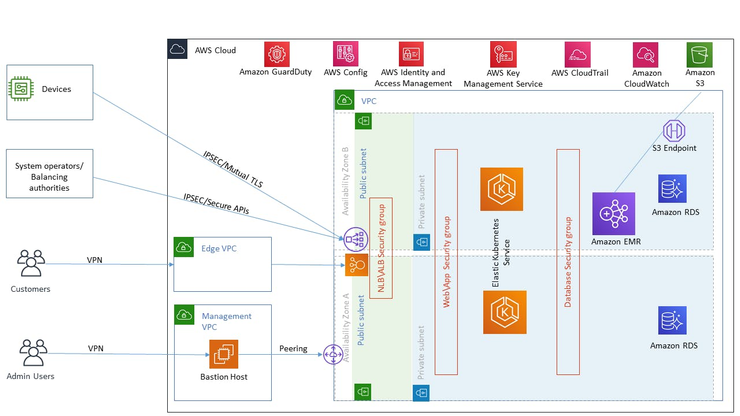
A representation of AWS cloud security services. Source: AWS Amazon
Scaling automation across the enterprise
The automation trend has shifted to hyperautomation. Automation, as we once knew it, focused on the digitalisation of separate tasks. Hyperautomation, on the other hand, is a disciplined, business-driven way of rapidly identifying, vetting and automating as many business and IT processes as possible. Through the use of AI, robotic process automation (RPA), ML, and other cutting-edge technologies, hyperautomation allows us to create complex automation solutions that can constantly evolve and learn.
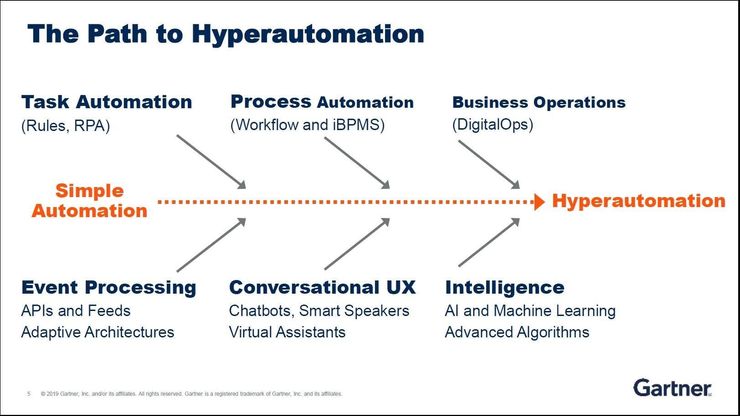
A good illustration of this trend is the successful implementation of RPA in some banks. For instance, ICICI Bank implemented RPA for over 1,350 routine processes, minimising reaction time by up to 60% while improving performance by 100%. A close competitor of ICICI, HDFC Bank, used hyperautomation to reduce its loan processing time by half, which in turn meant the bank could handle 50% more loans. Furthermore, HDFC's advanced loan processing system provides real-time access to credit administrators, resulting in a 12% increase in productivity.
AI‑powered data analytics
Data-driven decision making is an essential part of digital transformation since it helps improve business processes and overall strategies. But after collecting such large amounts of data, enterprises encounter the problem of fast, efficient data processing. AI seems to be the only efficient solution to this problem. Thus, it is no surprise that artificial intelligence will lead digital transformation trends in 2022.
As AI becomes increasingly accessible, every company will incorporate it into its systems and processes, from tech-savvy startups to large corporations. Using AI tools, organisations will be able to identify trends, make decisions, forecast, and perform hundreds of other routine tasks. In 2022, the main focus will be on:
Responsible AI – AI systems that are developed and integrated based on ethical and secure principles to ensure fairness, interpretability, privacy, and security
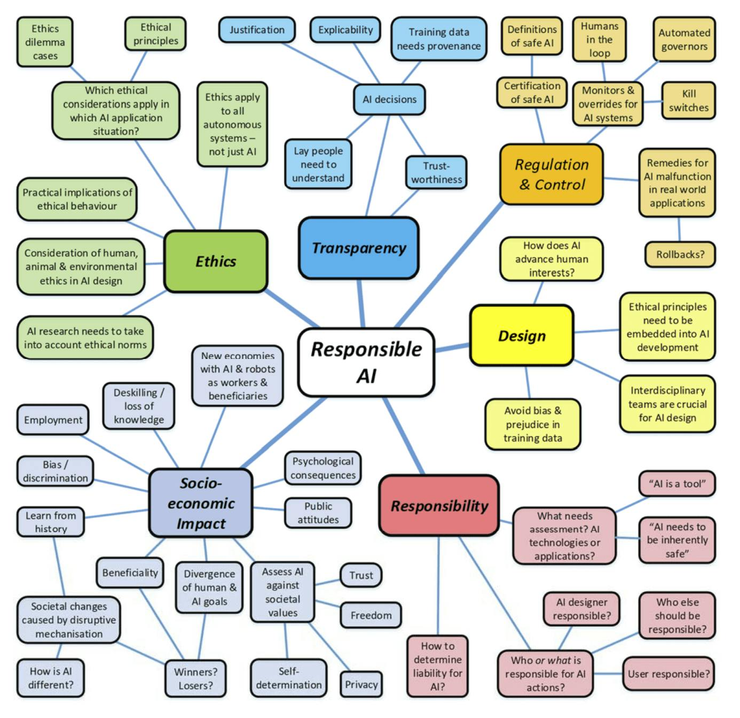
Source: NGI
Creative AI – AI algorithms that can simulate human creativity: generate marketing copies and social media content, create paintings, music, poetry, and so on.
Embedded AI – An approach that integrates AI into every aspect of a company's operations and infrastructure.
Hybrid working and cross-functional teams
The idea of remote working was in the air before the Covid-19 crisis, but it didn't gain much traction. The pandemic changed that with millions of people transitioning to remote work overnight. Now, after two years of restrictions and periodic lockdowns, there is no turning back. While human resources departments struggle to get staff back into the office, CEOs are building and implementing strategies for hybrid working. The concept is to reconfigure enterprise operations and transform platforms to allow workers to remain connected and productive, despite any setbacks.
Along with remote and hybrid working, the trend for distributed cross-functional teams is on the rise. The concept relies on two main principles. First, the team members work remotely. Second, team members come from different areas of an organisation, bringing original ideas and creativity to a project. In order to produce effective results, every team focuses on a different vertical. Plus, team members bring a unique perspective to the table, and they promote a collaborative culture by maximising resources.
How to get started with digital transformation
Don't overlook the importance of building a solid foundation when implementing some of the digital transformation trends discussed above. Make sure that your company creates a digital culture, has a data strategy, and optimises its operations along with moving to the cloud from legacy systems. The only way to achieve real digital transformation and leverage cutting-edge technologies for business productivity is through a complex approach that avoids any common pitfalls.
A cloud-native approach is best suited to meet the goals of digital transformation because it was created specifically for that purpose. At MadAppGang, we use this approach in our newest projects, such as Evergen. A cloud-native approach not only enables us to develop modern cloud apps faster, but also to set up optimal workflows for efficient update deployment and further software support and management. Besides, this approach allows enterprises to benefit from all the advantages of public, private, and hybrid clouds: resilience, scalability, and the ability to implement all the latest technologies.
A successful digital transformation project also requires experienced professionals who can breathe life into it. Whether you're looking for a helping hand for your IT department or a team who can handle the project from A to Z, you can count on MadAppGang to make your project a success. Reach out to us and let's discuss how our experts and the cloud-native approach can make these digital transformation trends work for your business.
